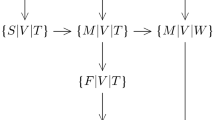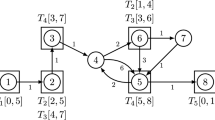Abstract
This paper introduces a new integrated model for the combined days-off and shift scheduling problem (the tour scheduling problem). This model generalizes the forward and backward constraints, previously introduced by Bechtold and Jacobs for the shift scheduling problem, to the tour scheduling problem. This results in a general and compact formulation that can handle several types of scheduling flexibility. We also provide a new proof of the correctness of forward and backward constraints based on Benders decomposition. The latter approach is interesting in itself because it can be used to solve the problem when extraordinary overlap of break windows or start-time bands is present. A discussion of model size for a set of hypothetical test problems is presented to show the merits of the new formulation.
Similar content being viewed by others
References
Aykin, T. (1995). “Reformulating the Tour Scheduling Problem to Improve Solvability.” GSM Working paper 95-29, Graduate School of Management, Rutgers University, Newark, NJ.
Aykin, T. (1996). “Optimal Shift Scheduling with Multiple Break Windows.” Management Science 42(4), 591–602.
Aykin, T. (1998). “A Composite Branch and Cut Algorithm for Optimal Shift Scheduling with Multiple Breaks and Break Windows.” Journal of the Operational Research Society 49, 603–615.
Aykin, T. (2000). “A Comparative Evaluation of Modeling Approaches to the Labor Shift Scheduling Problem.” European Journal of Operational Research 125, 381–397.
Bailey, J. (1985). “Integrated Days off and Shift Personnel Scheduling.” Computers and Industrial Engineering 9, 395–404.
Baker, K.R. (1976). “Wokforce Allocation in Cyclic Scheduling Problems: A Survey.” Operational Research Quarterly 27, 155.
Bartholdi, J.J. (1981). “A Guaranteed-Accuracy Round-off Algorithm for Cyclic Scheduling and Set Covering.” Operations Research 29, 501–510.
Bechtold, S.E. and M.J. Brusco. (1994). “Working Set Generation Methods for Labor Tour Scheduling.” European Journal of Operational Research 74, 540–551.
Bechtold, S.E. and L.W. Jacobs. (1990). “Implicit Modeling of Flexible Break Assignments in Optimal Shift Scheduling.” Management Science 36, 1339–1351.
Bechtold, S.E. and L.W. Jacobs. (1993). “Labor Utilization Effects of Labor Scheduling Flexibility Alternatives in a Tour Scheduling Environment.” Decision Sciences 24, 148–166.
Bechtold, S.E. and L.W. Jacobs. (1996). “The Equivalence of General Set-covering and Implicit Integer Programming Formulations for Shift Scheduling.” Naval Research Logistics 43, 233–249.
Bechtold, S.E. and M.J. Showalter. (1987). “A Methodology for Labor Scheduling in a Service Delivery System.” Decision Science 18, 89–107.
Blais, J.Y., J. Lamont, and J.M. Rousseau. (1990). “The Hastus Vehicle and Manpower Scheduling at the Société de Transport de la Communauté Urbaine de Montral.” Interfaces 20, 26–42.
Brusco, M.J. and L.W. Jacobs. (1993). “A Simulated Annealing Approach to the Cyclic Staff-Scheduling Problem.” Naval Research Logistics 40, 69–84.
Brusco, M.J. and L.W. Jacobs. (1995). “Cost Analysis of Alternative Formulations for Personnel Scheduling in Continuously Operating Organisations.” European Journal of Operational Research 86, 249–261.
Brusco, M.J. and L.W. Jacobs. (2000). “Optimal Models for Meal-Break and Start-Time Flexibility in Continuous Tour Scheduling.” Management Science 46, 1630–1641.
Brusco, M.J., L.W. Jacobs, R.J. Bongiorno, D.V. Lyons, and B. Tang. (1995). “Improving Personnel Scheduling at Airline Stations.” Operations Research 43, 741–751.
Burns, R.N. and M.W. Carter. (1985). “Work Force Size and Single Shift Schedules with Variables Demands.” Management Science 31, 599–607.
Dantzig, G.B. (1954). “A Comment on Edie's Traffic Delays at Toll Booths.” Operations Research 2, 339–341.
Easton, F.F. and D.F. Rossin. (1991). “Sufficient Working Subsets for the Tour Scheduling Problem.” Management Science 37, 1441–1451.
Gamache, M., F. Soumis, G. Marquis, and J. Derosiers. (1999). “A Column Generation Approach for Large Scale Aircrew Rostering Problems.” Operation Research 47(2), 247–262.
Hoffman, K.L. and M. Padberg. (1993). “Solving Airline Crew Scheduling Problems by Branch-and-Cut.” Management Science 39, 657–682.
Hueter, J. and W. Swart. (1998). “An Integrated Labor-Management System for Taco-Bell.” Interfaces 28, 75–91.
Jacobs, L.W. and M.J. Brusco. (1996). “Overlapping Start-Time Bands in Implicit Tour Scheduling.” Management Science 42, 1247–1259.
Jacobs, L.W. and M.J. Brusco. (1998). “Personnel Tour Scheduling when Starting Time Restrictions Are Present.” Management Science 44, 534–547.
Jarrah, A.I.Z., J.F. Bard, and H. DeSilva. (1994). “Solving Large-Scale Tour Scheduling Problems.” Management Science 40, 1124–1144.
Mabert, V.A. and M.J. Showalter. (1990). “Measuring the Impact of Part-Time Workers in Service Organizations.” Journal of Operational Management 9, 209–229.
Mabert, V.A. and C.A. Watts. (1982). “A Simulation Analysis of Tour-Shift Scheduling Construction Procedures.” Management Science 28, 520–532.
Moondra, S.L. (1976). “An L.P. Model for Work Force Scheduling in Banks.” Journal of Bank Research 6, 299–301.
Morris, J.G. and M.J. Showalter. (1983). “Simple Approaches to Shift, Days-off and Tour Scheduling Problems.” Management Science 29, 942–950.
Nemhauser, G. and L. Wolsey. (1988). Integer and Combinatorial Optimization. New York: Wiley.
Schindler, S. and T. Semmel. (1993). “Station Staffing at Pan American World Airways.” Interfaces 23, 91–98.
Thompson, G.M. (1995). “Improved Implicit Optimal Modeling of the Labor Shift Scheduling Problem.” Management Science 41, 595–607.
Vance, P.H., C. Barnhart, E.L. Jhonson, and G.L. Nemhauser. (1997). “Airline Crew Scheduling: A New Formulation and Decomposition Algorithm.” Operations Research 45, 188–200.
Author information
Authors and Affiliations
Rights and permissions
About this article
Cite this article
Rekik, M., Cordeau, JF. & Soumis, F. Using Benders Decomposition to Implicitly Model Tour Scheduling. Annals of Operations Research 128, 111–133 (2004). https://doi.org/10.1023/B:ANOR.0000019101.29692.2c
Issue Date:
DOI: https://doi.org/10.1023/B:ANOR.0000019101.29692.2c




